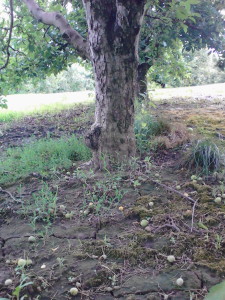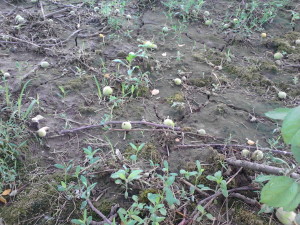Welcome rains have come to the orchard this week. Conditions were getting dry and we were concerned about the new plantings and the stress that the trees were undergoing because of the lack of rain. Things are looking better now.
“June drop” is occurring in the orchard. Sometimes it is disheartening to walk through the orchard and notice the number of small, immature apples dropping from the trees and littering the ground beneath the canopy. June drop is a natural life cycle of the trees. Apple trees produce many more flowers and young apples that it can possibly support to maturity. Only one bloom in every twenty is needed for a good crop on a mature apple tree.
Fruit trees set fruit so that they can produce seed. Too large a crop will strain the tree’s reserves and result in small fruits. The tree protects itself and its seed by thinning its crop after it senses weather and growing conditions are stable.
The first drop begins just after the petals fall from the trees and may continue for the next two or three weeks. At this stage, the apples are not much bigger than a pea. Inadequate pollination is a common cause of apples dropping at this stage. Most apple varieties produce little or no fruit when pollinated by their own pollen. They need to cross-pollinate with a different apple variety. Honeybees are the most important pollinator of apple trees. Cold, rainy weather prevents bees from flying and collecting pollen. If inclement weather persists through the bloom period, honeybees will not get the chance to pollinate the apple blossoms. If apples don’t get pollinated they drop.
A second drop occurs later and this is known as “June Drop.” By this time, the apples are between one-half inch to one inch in diameter. Again this is part of the natural life cycle of the tree. If the tree cannot support the fruit it sheds it. The most accepted explanation for the June drop is the temporary lack of adequate carbohydrates in the plant. Apple trees need ample carbohydrates to produce apples. Photosynthesis is reduced in cloudy weather and low temperatures and this causes a carbohydrate shortage. High nighttime temperatures stimulate higher respiration rates and this also further lowers the reserves of carbohydrates.
There are other causes of premature apple drop and these include disease, nutrient deficiencies or toxicities, profuse blooming and over pollination. Excessive heat, irregular watering and sudden changes in humidity and certain herbicides can also lead to fruit damage and dropping.


